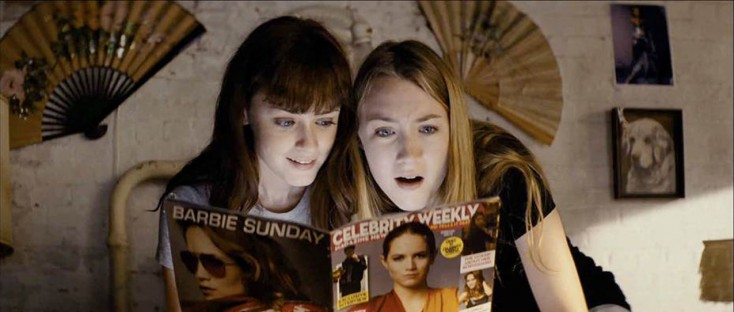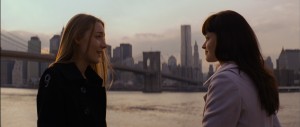By ANGELA DAWSON
Front Row Features
HOLLYWOOD—In an industry full of troubled young actresses like Lindsay Lohan and Amanda Bynes, Saoirse Ronan is an exception. The Dublin-born teen does all of her acting out onscreen. She’s played a trained killer in “Hanna” and reputation-ruining little liar in “Atonement.” She earned an Academy Award nomination for the latter. In person—and over the phone—though, she is funny, smart and extremely charming. Talented and reliable, she also is in-demand by top-flight directors, which is why audiences usually don’t have to wait too long to see her in a new film.
She calls one morning from Detroit, where she is filming a movie called “How to Catch a Monster.” She casually drops that she is working with Ryan Gosling, who is making his feature film directorial debut.
“He’s doing such a great job,” the 19-year-old praises in her distinctive brogue. “He’s got a great cast and everyone’s getting on very well. It’s just really really cool.”
Ronan could go on all day about Gosling, the new film and even Detroit, but she’s actually on the line to discuss “Violet & Daisy,” a quirky violent dark comedy she made two years ago that is just hitting theaters.
She plays Daisy, a gum-chomping teen who happens to also be an assassin, along with her best friend Violet (played by “Gilmore Girl”’s Alexis Bledel). Hoping to raise cash to buy some cool outfits to see their favorite singer, a Lady Gaga-like Barbie Sunday, in concert, the girls take on a new hit. They soon discover a kind of reckoning in the form of a suicidal shut in named Michael (James Gandolfini). The terminally ill target actually wants the girls to kill him, which gives them pause. Over the course of an afternoon, the pint-size killers begin to realize what they’re doing is wrong.
The film marks the directorial debut of Geoffrey Fletcher, who wrote the Academy Award-winning “Precious” screenplay based on the novel “Push” by Sapphire. He also wrote the “Violet & Daisy” screenplay, which attracted Ronan’s attention.
“With this one, Geoffrey (Fletcher) had me in mind,” she says. “That was quite nice. He sent me the script and I completely loved it.”
“It’s very much a black comedy, which I’d never done before,” she continues. “I love those kinds of films. I love (Quentin) Tarantino films, which this kind of reminds me of in a way. I felt how real it was in some ways. It’s a sophisticated, silly situation that these two girls are in. It’s a world they’ve created for themselves. They’ve lost touch with reality.”
She describes the first half of the film as “very out there,” and the second half “more grounded and a lot more realistic.”
“It’s more about friendship and how that changes,” she says. “I like that change in the script. My character, Daisy, goes through such a massive change and has a big revelation. I knew it would be great to do something like that.”
With just two other main co-stars, Ronan says she, Bledel and Gandolfini got a chance to get to know each other well.
“Alexis and I had a couple of weeks beforehand to rehearse,” she says, adding, “we became good friends.
Gandolfini, who most recently was seen in “The Incredible Burt Wonderstone,” joined the production a couple weeks into shooting.
“When Jim came on set, it felt like it was team then,” recalls Ronan. “He really looked after us, so it was lovely. We’d have fun on set between takes. There were long days. It was kind of neat. I remember some of the (assistants) actually recreated the scene from “Back to the Future” and decorated our car with lights and things like that. So the whole crew on that was really great.”
Having never seen “The Sopranos,” Ronan says she had few preconceptions about Gandolfini.
“I knew he played Tony Soprano, or at least I knew what the character was, but I didn’t know what to expect,” she says.
She says her father was more excited about meeting the actor because he was a fan of the award winning crime drama series in which he starred.
“One day we were shooting this scene at an apartment in Harlem,” recalls the actress. “I remember Jim was in there. He’s a really tall man and towers over everyone. My dad was standing there in awe because he was half a foot away from Jim Gandolfini. Some people have a certain overwhelmed reaction but he’s so great and he really looked after me on set. He was very protective over me. So that was really great.”
Ronan was in awe of Fletcher, having seen “Precious,” about an abused teenage girl. She was excited to work with the writer on his directorial debut. She sees some similarities tone-wise to “Violet & Daisy.”
“They let their imaginations take over and they create this world of theirs,” she says of the girls in each of the films.
For Ronan, handling the weapons in the film was not a big deal. She’d already learned about firearms in other films including “Hanna.” Nevertheless, she and Bledel visited a shooting range to ensure they looked natural holding and firing guns in “Violet & Daisy.”
“It’s a valuable thing to know,” she says about weapons training. “It’s come up a few times that I’ve had to shoot a gun. You learn how to be careful and safe.”
Ronan recently wrapped production on Wes Anderson’s “The Grand Budapest Hotel,” which is due out next year.
“I loved it,” she says. “You’re on for a day, and then you’re off for a week and then you’re on for a day (again), but when you are on set, it’s so wonderful. You’re literally stepping into his world. Everything is so Wes Anderson. The sets are so beautiful and there’s such attention to detail, the props. I don’t think I can tell you anything about it but there are these little cakes that we have in a few scenes that are just so beautiful. And they’re all real. None of them are fake. They’re all real cakes. It’s just things like that he really cares about and it makes such a big difference to the look of the film.”
In her downtime, the 19-year-old enjoys listening to music. Her favorite acts include an American pop duo called Beach House and the Swedish folk duo First Aid Kit.
Though she says she’d love to be in musical someday, she’s still a bit shy about singing in front of people.
“I like folky stuff,” says the Dubliner. “I don’t know if I’m any good at it but I like it.”





